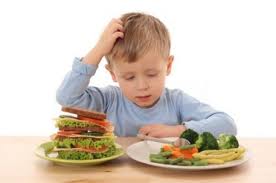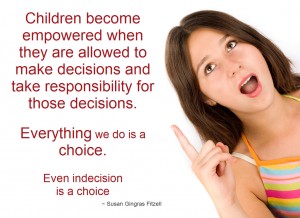 Many children grow up unable to make decisions because they have had little experience in doing so. Teaching decision making greatly benefits them in life.
Many children grow up unable to make decisions because they have had little experience in doing so. Teaching decision making greatly benefits them in life.
Life involves making decisions and choices. It is something people do everyday, sometimes consciously, sometimes unconsciously. The value of making conscious mindful decisions and choices is key to living a full and happy life. Children if presented with choice at a young age learn this invaluable tool easily and will greatly benefit them in their adolescent and adult lives.
Benefits of Providing Children with Choice
R. Renee Bembry’s article Giving Children Choices Rather Than Commands sites many benefits to giving children choices starting at a young age. Choices, if presented appropriately, will enable children to learn the benefits of making mindful, conscious decisions.
Giving children choices teaches them how to make decisions, builds their self esteem, develops problem solving skills, independence and makes them feel more powerful and in control of their lives. It teaches them to take ownership of their choices, the value of sacrificing one thing for another and makes them feel that their point of view is valued.
As parents, providing the child with a choice helps to avoid power struggles and reduces frustration while gaining the child’s cooperation. Done correctly this still leaves the parent in control as they are the ones who provide the choices.
How to Provide Choices to a Child
Some parents panic thinking that if they give their child a choice that they will soon be ruling the roost. This is not so, as the parent can choose what the choices will be, and therefore can choose things that they can live with. It is a win win for everyone as the child feels empowered because he gets to choose and the parent still holds the reins by providing choices that they are comfortable with either way.
Dr. Khrista Boylan, child psychiatrist, says to start teaching a child how to make decisions, the parent needs to ensure the choice is manageable and realistic for the age of the child. Do not offer choices to children younger than 2 years of age, and not more than 2 options, a or b. The choices need to be realistic, appropriate and acceptable, something the child understands, and the options need to be acceptable to the parent. Do not offer a choice if one of the choices is not acceptable.
As the child gets older one can offer them a broader range of choices. This will help eliminate power struggles with older children.
Parents need to be consistent and let the child choose on a regular basis. It is also important to note that not everything has to be a choice -there are times when as a parent, they must tell the child what to do.
Where to Start Offering Choice
 Jamie Sullivan’s article Parenting Tips – Why Is Giving Choice Important suggests that the parent start to offer children choice with everyday things like choosing what to wear, what to have for dinner or type of sandwich for lunch. They can be asked for input on family decisions such as what type of outing they would like to go on, or who to invite to play. As they get older the choices can become more complex and where the consequences of their choices become more pertinent. The more opportunities they have to make choices the more they will learn and the more confident they will become in making decisions.
Jamie Sullivan’s article Parenting Tips – Why Is Giving Choice Important suggests that the parent start to offer children choice with everyday things like choosing what to wear, what to have for dinner or type of sandwich for lunch. They can be asked for input on family decisions such as what type of outing they would like to go on, or who to invite to play. As they get older the choices can become more complex and where the consequences of their choices become more pertinent. The more opportunities they have to make choices the more they will learn and the more confident they will become in making decisions.
The Value of Good Decision Making
The key to success is knowing the child and what they can handle. This way the parent can provide realistic choices that will ensure the child feels empowered and learns from his experience.
As parents, providing choice builds the foundation for children to make good, sound decisions, where they learn to see the outcomes and accept the consequences (if any) of choosing one over another. This helps them make positive choices in their adolescent years when choices can be potentially life threatening. Teaching them early will only benefit them later in life and develop confident, happy adults.
